SLVAF45 August 2021 TPS51397A , TPS566231 , TPS566235 , TPS566238 , TPS568230
4 Cff Choose Method
This method is implemented by letting the gain cross 0dB with -20dB/decade slope [7]. To be noted, -20dB/decade gain at 0dB is not a necessary condition for stability. So this method just provides an allowable range for Cff and it doesn’t mean the converter will be unstable if Cff exceeds this range.
For the case as Figure 4-1(a) when the ripple injection zero frequency ωRI is larger than bandwidth, we can add the Cff zero ωz inside bandwidth, then the loop gain can cross 0dB with -20dB/decade, as shown in Figure 4-1(b).
In the case as Figure 4-2, the zero and pole introduced by Cff are both added inside bandwidth and the system stability can still be ensured. Although the slope of loop gain becomes -40dB/decade again after the pole ωp, the loop gain increasement with Cff makes the bandwidth increased and the ωRI becomes smaller than bandwidth. A -20dB/decade crossing is achieved and system will have enough phase margin.
In the case as Figure 4-3, both the zero and pole introduced by Cff are inside bandwidth, but the ripple injection zero frequency ωRI is still larger than the bandwidth. At this condition, the loop gain will still cross 0dB with -40dB/decade, which can’t ensure the system phase margin.
Above all, we can conclude two restrictions to achieve a stable state with -20dB/decade crossing after adding feedforward capacitor:
A. ωz<ωcross; B. avoiding the condition as Figure 4-3.
First we could deduct the limit for restriction A. Based on Figure 4-4, we can know that ωz<ωcross can be achieved by ensuring ωz<ωc. The expression of ωc is as equation (4). With equations (2) and (4), the lower limit of Cff is derived as equation (5).
 Figure 4-4 D-CAP2 Converter Loop Gain When
Adding ωz< ωcross
Figure 4-4 D-CAP2 Converter Loop Gain When
Adding ωz< ωcross

To get the limits for restriction B, we could know that Equation 6 corresponds the condition as Figure 4-3. Then the restriction B to avoid that condition corresponds to Equation 7.


where Ap is the amplitude of gain at ωp.
To get the expressions of Ap and ωcross, we can first get the relation between gain and frequency as Equation 8 through Equation 10.



Substituting Equation 2 through Equation 3 into Equation 8 through Equation 10, the expressions of Ap and ωcross can be received as Equation 11 and Equation 12.


Substituting Equation 11 and Equation 12 into Equation 7, we can get Equation 13 as equation for restriction B.

Combine the Equation 5 for restriction A and Equation 13 for restriction B, Equation 14 and Equation 15 are the limits for Cff.


At the meantime, the bandwidth after adding Cff should also be limited under 1/3*fsw. Since it is hard to give a unified method for the estimation of bandwidth and phase margin after adding Cff, it is suggested to verify with the help of simulation model or bench loop test results.